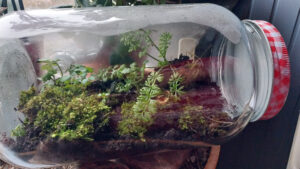Every tropical natural farm I have read or learned about starts with planting bananas. Bananas are essential to growing any food forest or Agroforestry system in the tropics.
The reasons for this are because of bananas:
- Grow fast
- Produce a lot of biomass
- Can survive droughts
- Can survive floods
- Shade the soil quickly
- Are edible
As you can see bananas are the perfect way to kick-start a forest. If bananas are densely planted everything underneath will be shaded and this will kill the weeds and grasses. It will also cool down the soil and protect it from the hard tropical sun to allow microorganisms and insects to thrive. The long big leaves also protect from strong rains and reduce water evaporation from the soil. Fruit and wood trees; and shade-loving crops can be planted underneath the bananas. Fruit trees when young are quite fragile so they need some shade protection. Normally fruit trees would grow up under the shade of their mother tree, but in deforested lands, there are no large mother trees to protect them; therefore bananas are the quick and easy solution.
When the fruit or wood trees outgrow the bananas, then the bananas can be cut down and used as an excellent fertilizer for the fruit trees.
So naturally, I wanted to buy a lot of bananas, about 250 to 500 bananas. Last year I bought 10 bananas from a nursery to test if they were any good, before buying more. I bought 1 banana for 50 PHP each. Sadly most of them died, the main reason is cause I planted them at almost the start of the dry season, but I was a bit impatient to wait for the rainy season. Also, the seller told me they would easily survive, of course, it was stupid for me to believe him.
Around 6 months later the rainy season started beginning. Other farmers around here are preparing to plant bananas. After some talk with my neighbor, he agreed to sell me 250 bananas for 25 PHP per banana. Half the price of the nursery. The neighbour talked to many other farmers in the area and told them to deliver bananas. Nobody had 250 bananas, the biggest plantation had only around 60 available. So we got 50 from 1 farmer, 50 from another, and so on. After 6 farmers had delivered their bananas we got to 250.
In the picture above you can see 50 of the banana rhizomes ready to be planted.
The other farmers said that we now have the biggest banana plantation in the whole area and that soon people would have to start buying bananas from us to plant new ones.
And we have only filled about half of the land with bananas, the other half will probably be filled next year.
The neighbour said each banana will grow 6 new ones, which means we will have 1500 bananas after just 1 year. However, I do not know if this is the best scenario or just average. I am expecting each banana to grow only 2 new bananas so we’ll get more or less 500 bananas after a year.
We have around 180 Saba bananas and 68 Lakatan bananas.
The Saba banana is a local native banana that is a huge monster. Saba banana grows extremely big and tall. If I am correct they are one of the biggest bananas in the world. They create an enormous amount of biomass with very long wide leaves. Not only that, but they are also very drought and disease resistant. The only downside is that they grow a bit slower compared to other bananas and the fruits are less sweet, harder, and smaller.
The Lakatan banana is smaller and more susceptible to diseases, but the fruits are sweeter, softer, and longer. About 15 of the Lakatan bananas came from a source where the bananas were sick. The farmer told that the colony of his Lakatan bananas suddenly started dying.. the leaves became yellow and the stems rotted. That farmer had a monoculture of Lakatan bananas so maybe that has something to do with it, but I could be wrong.
I have planted the Saba bananas at a distance of 2 meters, even tho the recommended planting distance is 4 to 5 meters. Some natural farmers even recommend planting at a 1 to 1.5-meter distance, but they probably do not use the giant Saba bananas I have. I planted them very densely between my fruit trees so I can quickly shade out the soil and stop all the weeds from growing and create a moist climate perfect for microorganisms.
The lakatan banana planting distance is about 2.5 to 3.5 meters because they are smaller bananas.
I have also planted peanuts around every banana to help with soil recovery and smothering out the weeds. I am also planning to plant Taro around the bananas, but first I need to wait for more rain to come in June or August. Once the bananas start growing bigger together with the fruit trees I will start thinning the bananas until there is approximately a 5-meter distance between each. The banana stems are full of moisture and provide a good fertilizer once they are cut down. Some farmers also told me that edible mushrooms grow from the rotting banana trunks. Sadly, here the farmers do not use the banana stems as fertilizers which is a real shame, instead, they burn them or feed them to their cows.
Because Lakatan bananas are more susceptible to disease I planted them at a distance of 3 meters each to allow some airflow underneath and to not make the leaves touch each other. If I notice any weak bananas I can still thin them out.
The bananas were planted on a very hot day on 15 May, but 3 days later it rained, so I hope they are okay. I am excited to see the first leaves already growing.
UPDATE:
As of October 2021, most of the bananas are now fully grown and some are already producing fruits!







2 thoughts on “Banana Planting – Part 1 – 2020”
Nice
Pingback: Banana Planting – Part 2 – 2020 - Jihatsu Eco Farm